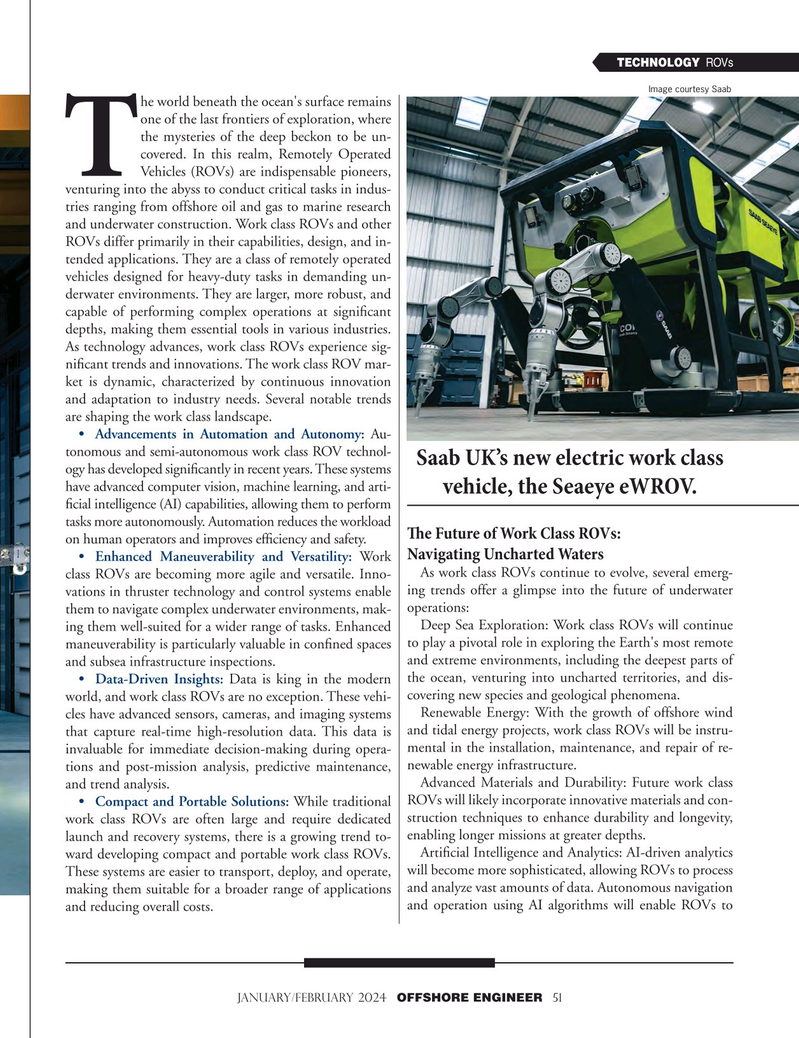
Page 51: of Offshore Engineer Magazine (Jan/Feb 2024)
Read this page in Pdf, Flash or Html5 edition of Jan/Feb 2024 Offshore Engineer Magazine
TECHNOLOGY ROVs
Image courtesy Saab he world beneath the ocean's surface remains one of the last frontiers of exploration, where the mysteries of the deep beckon to be un- covered. In this realm, Remotely Operated
T
Vehicles (ROVs) are indispensable pioneers, venturing into the abyss to conduct critical tasks in indus- tries ranging from offshore oil and gas to marine research and underwater construction. Work class ROVs and other
ROVs differ primarily in their capabilities, design, and in- tended applications. They are a class of remotely operated vehicles designed for heavy-duty tasks in demanding un- derwater environments. They are larger, more robust, and capable of performing complex operations at signifcant depths, making them essential tools in various industries.
As technology advances, work class ROVs experience sig- nifcant trends and innovations. The work class ROV mar- ket is dynamic, characterized by continuous innovation and adaptation to industry needs. Several notable trends are shaping the work class landscape.
• Advancements in Automation and Autonomy: Au- tonomous and semi-autonomous work class ROV technol-
Saab UK’s new electric work class ogy has developed signifcantly in recent years. These systems have advanced computer vision, machine learning, and arti- vehicle, the Seaeye eWROV.
fcial intelligence (AI) capabilities, allowing them to perform tasks more autonomously. Automation reduces the workload
Te Future of Work Class ROVs: on human operators and improves effciency and safety.
Navigating Uncharted Waters • Enhanced Maneuverability and Versatility: Work
As work class ROVs continue to evolve, several emerg- class ROVs are becoming more agile and versatile. Inno- vations in thruster technology and control systems enable ing trends offer a glimpse into the future of underwater operations: them to navigate complex underwater environments, mak-
Deep Sea Exploration: Work class ROVs will continue ing them well-suited for a wider range of tasks. Enhanced maneuverability is particularly valuable in confned spaces to play a pivotal role in exploring the Earth's most remote and extreme environments, including the deepest parts of and subsea infrastructure inspections.
• Data-Driven Insights: Data is king in the modern the ocean, venturing into uncharted territories, and dis- covering new species and geological phenomena.
world, and work class ROVs are no exception. These vehi-
Renewable Energy: With the growth of offshore wind cles have advanced sensors, cameras, and imaging systems that capture real-time high-resolution data. This data is and tidal energy projects, work class ROVs will be instru- mental in the installation, maintenance, and repair of re- invaluable for immediate decision-making during opera- tions and post-mission analysis, predictive maintenance, newable energy infrastructure.
Advanced Materials and Durability: Future work class and trend analysis.
• Compact and Portable Solutions: While traditional ROVs will likely incorporate innovative materials and con- work class ROVs are often large and require dedicated struction techniques to enhance durability and longevity, enabling longer missions at greater depths.
launch and recovery systems, there is a growing trend to-
Artifcial Intelligence and Analytics: AI-driven analytics ward developing compact and portable work class ROVs.
These systems are easier to transport, deploy, and operate, will become more sophisticated, allowing ROVs to process making them suitable for a broader range of applications and analyze vast amounts of data. Autonomous navigation and operation using AI algorithms will enable ROVs to and reducing overall costs.
january/february 2024 OFFSHORE ENGINEER 51

 50
50

 52
52